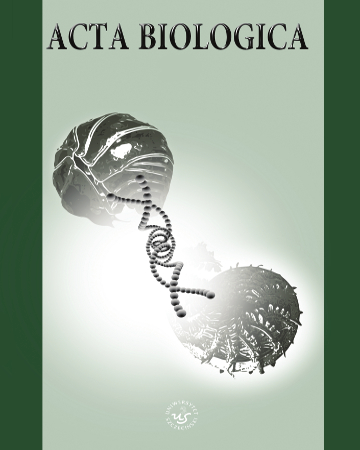
ISSN: 2450-8330
eISSN: 2353-3013
OAI
DOI: 10.18276/ab.2016.23-12



Issue archive /
No. 23
Morphological variation of Platanthera chlorantha (Orchidaceae) in forest sites of NW Poland
| Authors: |
Helena
Więcław
Department of Plant Taxonomy and Phytogeography, Institute for Research on Biodiversity, Faculty of Biology, University of Szczecin, Wąska 13, 71-415 Szczecin, Poland Bartosz Kurnicki Department of Botany and Nature Protection, Faculty of Biology, University of Szczecin, Felczaka 3a, 71-415 Szczecin, Poland |
| Keywords: | morphology labellum and spur variability PCA Dobrzany and Karnieszewice Forestries |
| Data publikacji całości: | 2016 |
| Page range: | 11 (139-149) |
Abstract
The aim of this study was to check a hypothesis on the morphological variability of the Platanthera chlorantha growing in forests in the north-west of Poland (Dobrzany and Karnieszewice Forestries). Statistical techniques were used to analyse 16 morphological characters determined in 174 flowering specimens. A special attention was paid to the size of the spur and labellum. The following morphological characters showed statistically significant differences: spur, labellum, ovary, bract, lateral sepal, leaves and height of the specimens. The differences are most likely a result of different habitat conditions and the location of the study sites.
Download file
Article file
Bibliography
| 1. | Bateman R.M., Rudall P.J. 2006. Evolutionary and Morphometric Implications of Morphological Variation Among Flowers Within an Inflorescence: A Case-Study Using European Orchids. Annals of Botany, 98: 975–993. |
| 2. | Bateman R.M., Sexton R. 2008. Is spur length of Platanthera species in the British Isles adaptively optimized or an evolutionary red herring? Watsonia, 27: 1–21. |
| 3. | Bateman R.M., Karen E., James K.E., Luo Y., Lauri R.K., Fulcher T., Cribb P.J., Chase M.W. 2009. Molecular phylogenetics and morphological reappraisal of the Platanthera clade (Orchidaceae: Orchidinae) prompts expansion of the generic limits of Galearis and Platanthera. Annals of Botany, 104: 431–445. |
| 4. | Claessens J., Kleynen J. 2006. Anmehungen zur Hybridbildung bei Platanthera bifolia und P. chlorantha. Journal Europäischer Orchideen, 38: 3–28. |
| 5. | Hultén E., Fries M. 1986. Atlas of North European vascular plants: north of the Tropic of Cancer. Königstein, Koeltz Scientific Books, p. 498. |
| 6. | Jeanmonod D., Gamisans J. 2007. (eds.). Flora Corsica. Édisud, p. 901. |
| 7. | Komarov V., Chernyakovskaya E. 1986. Flora of the U.S.S.R. (Flora SSSR). Volume 4: Liliiflorae and Microspermae. Bishen Singh Mahendra Pal Singh. Dehra Dun, India. |
| 8. | Lauber K., Wagner G. 2007. Flora Helvetica. Haupt Verlag, Bern-Stuttgard-Wien, p. 1631. |
| 9. | Matuszkiewicz W. 2006. Przewodnik do oznaczania zbiorowisk roślinnych Polski. In: Vademecum Geobotanicum 3. J.B. Faliński (ed.). Wyd. Nauk. PWN, Warszawa, p. 537. |
| 10. | Mirek Z., Piękoś-Mirkowa H., Zając A., Zając M. 2002. Flowering plants and pteridophytes of Poland – a checklist. In: Biodiversity of Poland 1, Z. Mirek (ed.). In. Szafer Institute of Botany, Polish Academy of Sciences, Kraków, p. 442. |
| 11. | Nilsson L.A. 1983. Processes of isolation and introgressive interplay between Platanthera bifolia (L.) Rich. and P. chlorantha (Custer) Reichb. (Orchidaceae). Botanical Journal of the Linnean Society, 87: 325–350. |
| 12. | Nilsson L.A. 1985. Characteristics and distribution of intermediates between Platanthera bifolia and P. chlorantha (Orchidaceae) in the Nordic countries. Nordic Journal of Botany, 5: 407–419. |
| 13. | Stace C.A. 1997. New Flora of the British Isles (2nd edn). Cambridge University Press, Cambridge, p. 1130. |
| 14. | Statsoft Inc. 2007. Statistica (data analysis software system), version 8.0. www. statsoft.com. |
| 15. | Stpiczyńska M. 2003. Floral longevity and nectar secretion of Platanthera chlorantha (Custer) Rchb. (Orchidaceae). Annals of Botany, 92: 191–197. |
| 16. | Webb D.A. 1980. Platanthera L.C.M. Rich. In: Flora Europaea 5, T.G. Tutin, V.H. Heywood, N.A. Burges, D.M. Moore, D.H. Valentine, S.M. Walters, D.A. Webb (eds.). Cambridge University Press, Cambridge, pp. 331–332. |
| 17. | Zając A. 1978. Założenia metodyczne atlasu rozmieszczenia roślin naczyniowych w Polsce. Wiadomości Botaniczne, 22 (3): 145–155. |
| 18. | Zając A., Zając M. (eds.) 2001. Atlas rozmieszczenia roślin naczyniowych w Polsce. Pracownia Chorologii Komputerowej Instytutu Botaniki Uniwersytetu Jagiellońskiego, Kraków, p. 714. |
| 19. | Zarzycki K., Trzcińska-Tacik H., Różański W., Wołek J., Korzeniak U. 2002. Ecological indicator values of vascular plants of Poland. In: Biodiversity of Poland 2. Z. Mirek Z. (ed.). W. Szafer Institute of Botany, Polish Academy of Sciences, Kraków, p. 183. |
| 20. | Żukowski W. & Jackowiak B. 1995. Lista roślin naczyniowych ginących i zagrożonych na Pomorzu Zachodnim i w Wielkopolsce. In: Ginące i zagrożone rośliny naczyniowe Pomorza Zachodniego i Wielkopolski. In. Żukowski, B. Jackowiak (eds.). Prace Zakł. Taks. Roślin UAM, Bogunki, Wyd. Nauk. Poznań, 3, pp. 9–96. |